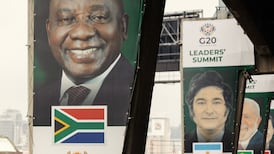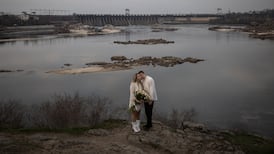The Netherlands is sending 40 unarmed military police to eastern Ukraine as part of an increased effort to find the last victims of the downed Malaysia Airlines Flight 17 still at the wreckage site.
Prime minister Mark Rutte announced he is also sending forensic investigators to the site to try to piece together exactly what happened when the plane was shot down a week ago, killing all 298 people on board.
US officials say the Boeing 777 was probably shot down by a missile from territory held by pro-Russian rebels, likely by accident.
Mr Rutte said the military police will help the investigators. “They are really looking like the forensic experts,” he said. “They will be extra hands and eyes to look for remaining remains and personal belongings.”
His comments came hours after two military planes carrying 74 coffins landed at a military base in the Netherlands yesterday.
A day earlier, the two military transport planes — one Dutch and one Australian - brought back the first 40 coffins and more flights were planned for today.
Thousands of people have turned out to watch the convoys of hearses drive from the Eindhoven Air Base to a military barracks in the central city of Hilversum, where the remains will be identified by an international team of experts.
The Netherlands has been given the lead in the investigation into what exactly happened to Flight 17 and is taking charge of efforts to identify the dead.
The nation of 17 million was the hardest hit, with 194 of its citizens on board the plane.
Mr Rutte said he would also be sending more forensic experts to the scene in the coming days to speed up the investigation that was hampered in its early stages because it was considered too dangerous to work there.
He acknowledged that the region of eastern Ukraine controlled by pro-Russian separatists remains a risky place to work. “For tomorrow, we expect our people to be able to conduct the work necessary,” he said. “But we will constantly reassess the situation.” He added: “We are looking into ways to make the crash site safer.”
That could include an international police mission.
Australian foreign minister Julie Bishop travelled yesterday to Kiev with her Dutch counterpart Frans Timmermans to seek an agreement with the Ukraine government that will allow international police to secure the crash site.
Australian prime minister Tony Abbott said: "We are ready to deploy Australian police to Ukraine to help secure the site as part of an international team under United Nations authority."
Australia has sent 50 police to London in anticipation of deploying them to Ukraine, he said.
Mr Rutte said he would not rest until he has brought the perpetrators to justice. “I’m extremely motivated to find out what happened, who did this,” he said. “And as soon as we know, I will do everything in my power — even if it is the last thing I do in this job — to make sure we bring them to justice.”
Elsewher the United States saidyesterday that Russia was firing artillery across its border with Ukraine to target Ukrainian military positions in the conflict with pro-Russian separatists.
State department spokeswoman Marie Harf also said there was evidence that the Russians intended to deliver heavier and more powerful multiple rocket launchers to the separatist forces.
Ms Harf, speaking at a regular media briefing, cited intelligence reports but said she could give no more information of what the reports were based on.
A US official, who spoke on condition of anonymity, said the artillery fire began on or after this Tuesday. The official declined to say what targets had been hit but said the United States had no evidence of civilian casualties.
The United States learned about the artillery fire through “technical and overhead“ intelligence systems, the official said, an apparent reference to spy satellites and signals-intelligence collection.
Russia has in the past denied it is directly involved with the rebellion in its western neighbor, but the United States and its European allies accuse Moscow of arming and encouraging the uprising and have imposed sanctions on Moscow in response.
A senior US official said during the last week, the United States had become aware of activity involving multiple rocket launch systems at a military base near the town of Rostov, in southwest Russia. US officials say they believe Ukrainian separatists had gone there to train on the weapons.
The US officials said such rocket systems have continued to “depart and return to Rostov at irregular intervals.“
d, citing a defense ministry official.
The United States has said it believes a Russian-made SA-11 ground-to-air missile fired from rebel-held territory in eastern Ukraine brought down a Malaysian Airlines jetliner last Thursday, killing the nearly 300 people on board.
One US official said that American agencies knew Ukrainian separatists were in possession of SA-11 missiles before the crash but that their understanding was that they were “defunct“ and inoperable.
Earlier this week, U.S. intelligence officials said that the United States only realized that the separatists had operational SA-11s after the Malaysian airliner was shot down.
PA/Reuters










